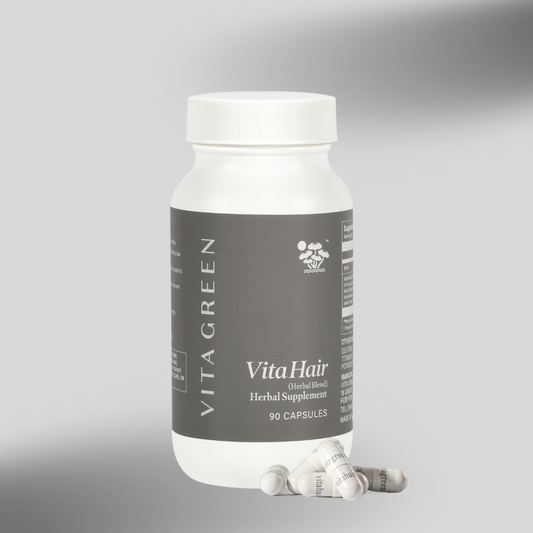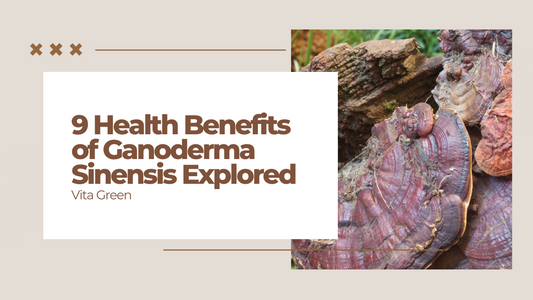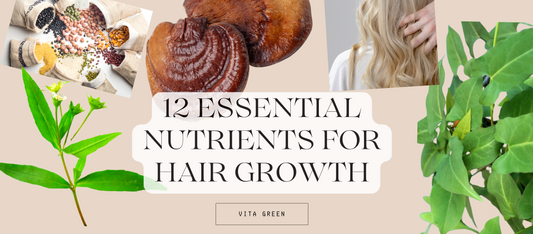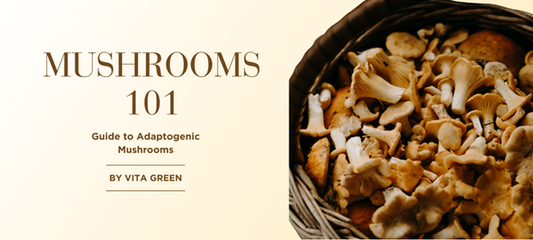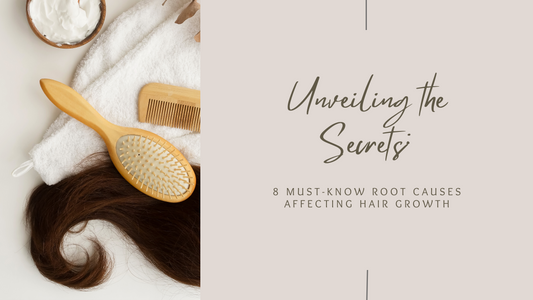Imagine waking up one morning to find a huge amount of hair strands on your pillow, and then looking in the mirror to realize that your hair is significantly thinner or that you have bald spots on your head. Do you witness masses of hair drifting down the plughole every time you wash your hair and you don't touch your hair or participate in intense exercise because you're afraid your hair may fall out in your palm?
It is commonly known that a lot of African American women out there are experiencing hair loss. This can be due to a number of factors, such as genetics, hormones, our hair type, the products we use, and our overall health or even something as simple as styling our hair in the wrong way. As African American women’s hair is full of coils and curls, which makes it more common to suffer from hair loss and trickier to growing long healthy locks.
There are plenty of things or natural way you can do to help encourage regrowth and keep your locks looking healthy and full. With the right tips and advice, you can achieve healthy hair growth no matter your race or ethnicity! Keep reading for some helpful tips on African American hair growth.
African American hair loss and how hair practices relate to scalp and hair problems
Although genetics can play a part in hair loss, many hairstyles and hair care practices are significant contributors to African American alopecia.
African American are more prone to three specific types of alopecia:
- Central centrifugal cicatricial alopecia (CCCA)
- Traction alopecia
- Breakage
African American women suffer from hair loss conditions like alopecia not only because of their hair type but can also be due to long-term use of tight hair styling that pull and strain at the hair root. According to an assistant professor of dermatology at Johns Hopkins University Hospital in Baltimore and an editor of the textbook “Fundamentals of Ethnic Hair: The Dermatologist’s Perspective.” It’s probably the most common form of hair loss we see in the black community,” This can result permanent hair damage such as hair thinning at the hairline or happen anywhere that hair is continuously pulled. Majority of the people who have experience these stylings claims pain and discomfort throughout the styling process or days and weeks after the process in their scalp.
Survey results of hair loss reason:
A study was done to examine whether there was a link between hair care practices correspond to scalp problems or hair loss and problems. African American girls from age 1 to 15 years old were asked to fill out a survey. The researchers used multivariate analysis on 98 dermatology and 103 nondermatological clinics with a total of 201 evaluations showed that:
- 99% used hair oils or grease
- 81% of ponytails were worn
- 67% of braids were worn
- 49% of cornrows were worn
- 61% said they washed their hair every two weeks
- 80% said they used hot combs
- 42% said they used chemical relaxers
95% of respondents who used cornrows, hair extensions, and infrequent hair oil showed a correlation to traction alopecia (Gathers,2014).
How fast does hair grow?
Hair is one of the fastest-growing tissues in the human body. The American Academy of Dermatology indicated that the average person's hair grows approximately 6 inches per year (1/2 inch per month on average). It is important to understand the hair growth cycle for individuals who want to know how to care for their hair.
How fast your hair grows depends on your:
- age
- specific hair type
- overall health
- other health conditions
Stages of hair growth:
Hair growth and loss may appear to be a straightforward process, but the hair growth phase is generally divided into four cycles. These hair growth phases have been thoroughly researched in order to obtain a better knowledge of how hair grows and what may be done to avoid or treat premature hair loss.
- Anagen phase (growing phase) growth and maturation of hair, as well as the activity of the hair follicles that create individual hair strands, last about 2-8 years
- Catagen phase (transition phase) where hair stops growing, last about 4- 6 weeks
- Telogen phase (resting phase) covers the growth and maturation of hair and when hair falls out, it last about 2-3 months
The last and final phase is the exogen phase where old hair will shed as new hair will start to grow in the follicles. Each phase and cycle have its own time frame that could be affected by various reason on a person’s nutrition intake, age, and overall wellbeing, this means that there are steps you can take to ensure your hair flows a healthy growth cycle.
There are different ways to help hair grow, fixing your daily routines may help you grow your hair faster. It's not easy for African American women to find a way to stop hair loss or hair regrow overnight but there are ‘natural’ ways to help reduce hair loss and how to take care of and help regrow your curly hair.
10 Best Natural Advice On How To Make African American Hair Grow
1. Massaging the scalp regularly
According to Healthline massaging the scalp stimulates the scalp and may promote hair thickness when used in combination with hair oils and treatments. It is supposed to promote hair development and thickness in the epidermis cells, which are found at the root of the hair follicle. These cells are important in the development of hair, hair growth, and the falling and growth cycle.
2. Boost your nutrient profile
Getting enough protein, drinking enough water, and eating foods high in iron and zinc can all help you grow healthy, strong hair. B vitamins are also quite important for hair growth so intaking foods like nuts, seeds, and avocados, as well as dark leafy greens, whole grains, and healthy fats like olive. Intake of all these nutrients to avoid deficiencies that might lead to hair loss.
3. Wash hair once a week or even less
According to the American Academy of Dermatology (AAD), tightly coiled hair should be washed once a week or even less. As continuous washing can eliminate care products and remove natural hair oil, potentially drying out the scalp and hair.
4. Use natural oil: Rosemary Oil and Geranium Oil
Rosemary Oil is a popular essential oil for promoting hair development and help decrease hair loss. Rosemary oil has been shown to promote new hair growth and is known to help treat male pattern baldness or as known as androgenetic alopecia.
Geranium oil is a fragrant herb widespread from South Africa. Geranium oil is a pure essential oil extracted from the leaves of the geranium plant that helps hair regrowth and circulation.
Both natural can be applied directly to hair and massage gently on a daily basis or applied on your shampoo or conditioner.
5. Taking ginseng supplements
According to Healthline, Ginseng supplementation can help to increase new hair growth by strengthening hair follicles. Ginsenosides are the active ingredients that is included in ginseng that are considered to be essential for its hair-boosting properties.
6.Use herbs instead of medications
Both Minoxidil and finasteride are well-studied medicines that are generally considered safe. However, like other drugs, these two treatments have a number of limitations. Their effectiveness and safety are debatable, and the time needed to fulfill the desired result is both long and uncertain. This has raised attention to developing a new way to tackle hair loss by using treatments including herbs and or excluded active substances. Numerous research (mainly randomized, placebo-controlled) have been conducted on herbs and plant products to prove their efficacy in treating hair loss. (Zanoc, et al, 2020)
7. Use hair growth products like Vita Hair to supercharge your hair growth
Using high-quality, organically sourced, and medically reviewed product, like Vita Hair supplement. Vita Hair uses 13 types of natural herbs as the key ingredients to improve blood circulation and nutrient supply to the hair follicles in order to grow longer and thicker hair, research shows that taking Vita Hair increased 60% more hair growth than the control group in 90 days can help you avoid future hair loss, develop new hair strands, and keep your hair strong, smooth, and silky. Discover and notice yourself how much of a difference using herbs may achieve in a short amount of time.
8. Avoid using heat tools
Breakage occurs when the hair is damaged instead of the follicle. The hair shaft gets weaker and breaks off as a result of this damage. Overheating or excessive heat from straighteners, curling irons and hot combs, as well as chemicals that are used to straighten or hair dyeing. While the cause of this condition is unclear, it appears that our hair activities (from washing and straightening to braiding and weaving) can cause significant breakage and hair loss.
9. Go natural
Central centrifugal cicatricial alopecia (CCCA) is caused by continual use of weaves, braids, corn rows, extensions, chemical hair relaxers as well as other hair styling techniques. These various reasons can cause inflammation in the hair follicles, and if these techniques continue to maintain, permanent hair loss or damage may result.
10. Use a sulfate-free shampoo and deep conditioner
As American African have fragile, frizzy, curly hair, not all the shampoo are suitable for their hair. Sulfates are dangerous chemicals that can ruin your hair over time. So if you use shampoo with sulfates your hair will become more frizzy and dry. Choose a shampoo with natural ingredients instead of sulfates. Shampoo with natural oils are the best way to make hair smoother, moisturised, and grow way faster.
African American hair is unique in many ways. It is the most versatile type of hair, but it is also the most delicate. The natural oils that are produced by the scalp to protect and nourish the hair are not as prevalent on African American scalps and hair as they are on other head types. This can lead to problems such as scalp issues, dandruff, hair loss, and even baldness. In this blog post, we’ve shared 10 effective tips for promoting healthy hair growth naturally, by focusing more on using natural herbal ingredients to stop hair loss instead of medications. Try Vita Hair, a hair supplement that is well-known for using 13 types of natural herbs, and see the difference when you care for your curly hair from the inside!
Reference:
- Cronkleton, Emily. “10 Tips for Natural Hair Regrowth.” Healthline, Healthline Media, 19 Nov. 2021, https://www.healthline.com/health/regrow-hair-naturally#7.
- English, Robert S., and James M. Barazesh. "Self-assessments of standardized scalp massages for androgenic alopecia: survey results." Dermatology and therapy1 (2019): 167-178.
- Gathers, Raechele Cochran, and Meredith Grace Mahan. “African american women, hair care, and health barriers.” The Journal of clinical and aesthetic dermatology 7,9 (2014): 26-9.
- Kivi, Rose. “Male Pattern Baldness: Causes, Identification, and Prevention.” Healthline, Healthline Media, 6 Oct. 2015, https://www.healthline.com/health/male-pattern-baldness.
- Koyama, Taro et al. “Standardized Scalp Massage Results in Increased Hair Thickness by Inducing Stretching Forces to Dermal Papilla Cells in the Subcutaneous Tissue.” Eplasty 16 e8. 25 Jan. 2016
- Lewallen, Robin, et al. "Hair care practices and structural evaluation of scalp and hair shaft parameters in African American and Caucasian women." Journal of cosmetic dermatology3 (2015): 216-223.
- Matsuzaki, T, and K Yoshizato. “Role of hair papilla cells on induction and regeneration processes of hair follicles.” Wound repair and regeneration : official publication of the Wound Healing Society [and] the European Tissue Repair Society 6,6 (1998): 524-30. doi:10.1046/j.1524-475x.1998.60605.x
- Park, Gyeong-Hun et al. “Red ginseng extract promotes the hair growth in cultured human hair follicles.” Journal of medicinal food 18,3 (2015): 354-62. doi:10.1089/jmf.2013.3031
- Panahi, Yunes et al. “Rosemary oil vs minoxidil 2% for the treatment of androgenetic alopecia: a randomized comparative trial.” Skinmed 13,1 (2015): 15-21.
- Whelan, Corey. “Geranium Oil Benefits, Side Effects, and Uses on Your Skin and More.” Healthline, Healthline Media, 9 May 2019, https://www.healthline.com/health/geranium-oil#overview.
- Wright, Dakara Rucker, et al. "Hair care practices and their association with scalp and hair disorders in African American girls." Journal of the American Academy of Dermatology2 (2011): 253-262.
- Zgonc Škulj, Ana et al. “Herbal preparations for the treatment of hair loss.” Archives of dermatological research 312,6 (2020): 395-406. doi:10.1007/s00403-019-02003-x














